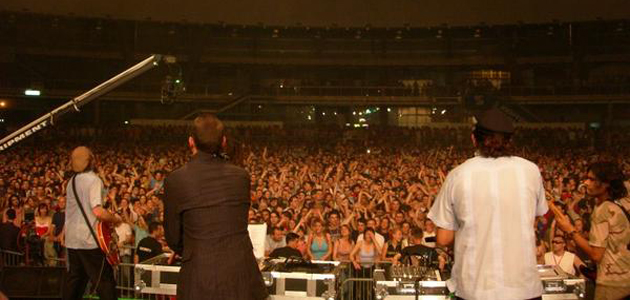
How many electronic musicians, or DJs for that matter, can walk out on stage at your favorite concert venue and lay waste to your mind with their style, their swagger and their stage presence?
This is not an easy task for any musician, configurable or otherwise, but historically one rocker after another has been able to capture the hearts and occasionally the undergarments of those in the front row with a hip shake and a little dance, guitar in hand.
This phenomenon is a combination of the stage performer/audience dichotomy coupled with traditional analog instrumentation.
Guitars, saxophones, violins etc. allow for not only free movement of the body, but the kinetic energy that activates them is used by musicians to claim the stage, and deliver it down to the audience from on high.
Most electronic musicians, on the other hand, rely upon instruments that function best while stationary. Many have tried, but a turntable, laptop or a midi controller are not easily played while carried or danced with. Digital instruments so require physical interaction, but the action needed to activate a sample clip, cue a record or press a midi keyboard is minuscule compared with the exaggerated semi-circular strum of a Fender Stratocaster or the blow of a jazz trumpet.
Prince:
So the question is, how can electronic musicians compete with a deck stacked against them?
Today, many will rely on laser light shows, oversized speaker props, glowing pyramids and clever masks to supplement the energy they are unable to produce given the limitations of their instruments all the while attempting to preserve the stage performer/audience relationship.
Deadmaus:
Justice:
For those not interested in channeling Houdini’s powers of misdirection, there is an alternative.
The first of which is to embrace the latest digital instruments, whether that be digital instruments masquerading as analog ones, or focusing on the development of new touch screen technologies that will create not only visual excitement, but allow for mobile use.
Laser Harp:
Akai EWI:
The second is to reexamine the nature of the stage, or subvert the stage performer/audience dichotomy altogether.
Dan Deacon often sets up his rig in the middle of the crowd, while mashup maestro, Girltalk, or Dubstep bad boy, Skrillex, will simply bring the crowd onto the stage with them.
Tom and Gary have created the decentralized dance party. With any venue, or no venue at all, they act as DJs with a master FM radio transmitter broadcasting locally to all attendees boom boxes. While they maintain the direction of the party, the stage is rendered obsolete.
In all of these scenarios, there is a lot less posturing and plenty of unbridled energy to be shared by all.
A mere 10 years ago, the idea of a performer willingly sharing the spotlight with his or her fans would have been seen as counterproductive to one’s identity construction. Today, it is quickly becoming the best way to be remembered.
Chris Alker, aka The Dance Machine/DJ By Night, is a New York based DJ, designer, party planner and writer.
Originally from Houston he moved to New York City in the winter of 2004 to work full time in the field of architecture. With a passion for dance music, art, architecture and fashion, he has tapped into the city’s creative pulse in an effort to share his ideas, his writings and cherished damaged-disco record collection.
He is is responsible for countless dance parties around town, is a contributing writer for Rockthedisco, Discosalt & Out Of Order Magazine, is an ambassador for the independent record label Subtrak, and has lectured on the art of the DJ at Yale University.[/box]



